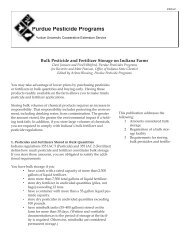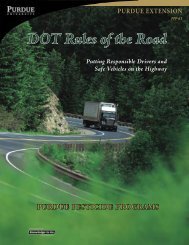Pesticides and Risk Communication PPP-52 - Purdue Pesticide ...
Pesticides and Risk Communication PPP-52 - Purdue Pesticide ...
Pesticides and Risk Communication PPP-52 - Purdue Pesticide ...
You also want an ePaper? Increase the reach of your titles
YUMPU automatically turns print PDFs into web optimized ePapers that Google loves.
8<br />
The Registration Branch was responsible for registering all products<br />
before they entered the market. Manufacturers wishing to register a<br />
product had to<br />
• provide efficacy data demonstrating product performance.<br />
• substantiate their claim that the product met USDA safety <strong>and</strong><br />
health criteria.<br />
• document truth in labeling: that the contents of the product were<br />
exactly as stated on the label.<br />
• include clearly stated use directions, on the label, to assist the<br />
user in gaining maximum benefit from the product.<br />
• describe, on the label, the use precautions necessary to ensure<br />
human <strong>and</strong> environmental safety.<br />
Government involvement continued to increase. In 1958, the Food<br />
<strong>and</strong> Drug Administration (FDA), through the Miller Amendment, worked<br />
with USDA to set tolerances for residues in food. Thus, manufacturers<br />
were required to submit data to show that pesticide residues in food<br />
from treated crops did not exceed established tolerances. During this<br />
period, most tolerances were around 7 parts per million, which corresponded<br />
to the sensitivity limit of analytical methods available at that<br />
time. <strong><strong>Pesticide</strong>s</strong> without detectable residues were assigned a “no<br />
residue” registration; <strong>and</strong> those with detectable residues were assigned<br />
a “residue” registration.<br />
The residue/no-residue registrations were challenged as improvements<br />
in technology allowed scientific detection of residues in parts per<br />
billion. This increased capability raised concerns because pesticides<br />
previously registered through USDA as “no-residue” products could now<br />
be shown to render residues detectable in parts per billion. The result<br />
was elimination of the “no-residue” registration.<br />
FIFRA was amended in 1964 to require USDA to refuse registration<br />
of pesticides determined unsafe or ineffective, <strong>and</strong> to revoke registration<br />
of <strong>and</strong> remove such existing products from the market. It also requires<br />
that all pesticide labels bear a USDA registration number; that the front<br />
label of all pesticides display a signal word—CAUTION, WARNING, or DAN-<br />
GER—<strong>and</strong> the phrase “Keep Out of Reach of Children”; <strong>and</strong> that all<br />
claims made about the “safety” of a product be removed from the label.<br />
Rachel Carson Introduced<br />
the Public to <strong>Pesticide</strong> <strong>Risk</strong>s<br />
In 1962, Dr. Rachel Carson published Silent Spring, a book that<br />
refocused <strong>and</strong> energized public debate on pesticides. Carson was a<br />
scientist with the U.S. Fish <strong>and</strong> Wildlife Service, <strong>and</strong> in her book she<br />
described the devastating effects of DDT on the environment. Silent




